Recent Posts
How to Safeguard Your Commercial Property from Storm Damage
7/24/2024 (Permalink)
 SERVPRO of West Pensacola parked in front of a large hospital for an emergency water job.
SERVPRO of West Pensacola parked in front of a large hospital for an emergency water job.
As a business owner in Pensacola, you understand the importance of protecting your commercial property from unforeseen events. Storms can cause significant damage, leading to costly repairs and downtime. At SERVPRO of West Pensacola, we specialize in helping businesses prepare for and recover from storm damage. Here’s how you can safeguard your property.
Assess Vulnerabilities:
- Identify potential weak points in your building, such as windows, doors, and the roof.
- Conduct regular maintenance to ensure everything is in good condition.
Create an Emergency Plan:
- Develop a comprehensive emergency plan that includes evacuation routes and contact information for all employees.
- Conduct regular drills to ensure everyone knows what to do during a storm.
Invest in Storm-Resistant Materials:
- Use storm shutters or impact-resistant windows to protect against flying debris.
- Reinforce doors and roofs to withstand strong winds.
Maintain Proper Drainage:
- Ensure gutters and downspouts are clear of debris to prevent water buildup.
- Consider installing a sump pump in basements to manage flooding.
Secure Outdoor Items:
- Anchor or bring inside any outdoor furniture, signage, or equipment that could become projectiles in high winds.
Preparation is key to minimizing storm damage to your commercial property. If your business does experience storm damage, SERVPRO of West Pensacola is here to help with 24/7 emergency services. Call us at 850-SERVPRO (737-8776) for prompt and professional assistance.
Effective Strategies for Managing Water Damage in Commercial Buildings
7/24/2024 (Permalink)
 SERVPRO of West Pensacola employee ready to stage equipment at a commercial water damage job.
SERVPRO of West Pensacola employee ready to stage equipment at a commercial water damage job.
Water damage can disrupt business operations and lead to significant losses. Whether it’s due to a burst pipe, flooding, or a leaky roof, addressing water damage quickly and efficiently is crucial. SERVPRO of West Pensacola provides expert water damage restoration services to help you get back to business faster.
Quick action is essential when dealing with water damage in commercial buildings. Trust SERVPRO of West Pensacola to provide the expertise and equipment needed to restore your property efficiently. Contact us at 850-SERVPRO (737-8776) for emergency services.
Top Tips for Preventing Mold in Commercial Properties
7/24/2024 (Permalink)
 Mold growing at a commercial property that SERVPRO of West Pensacola was hired to remove and remediate.
Mold growing at a commercial property that SERVPRO of West Pensacola was hired to remove and remediate.
Mold can pose serious health risks and damage your commercial property. Preventing mold growth is crucial for maintaining a safe and healthy environment for your employees and customers. SERVPRO of West Pensacola offers expert mold remediation services and shares these tips to help you prevent mold in your business.
Preventing mold in your commercial property requires vigilance and proactive measures. If you suspect mold growth, contact SERVPRO of West Pensacola for professional mold remediation. Our team is available 24/7 at 850-SERVPRO (737-8776) to help keep your business mold-free.
Protecting Your Home: Tips for Fire Prevention and Preparedness in Pensacola
3/14/2024 (Permalink)
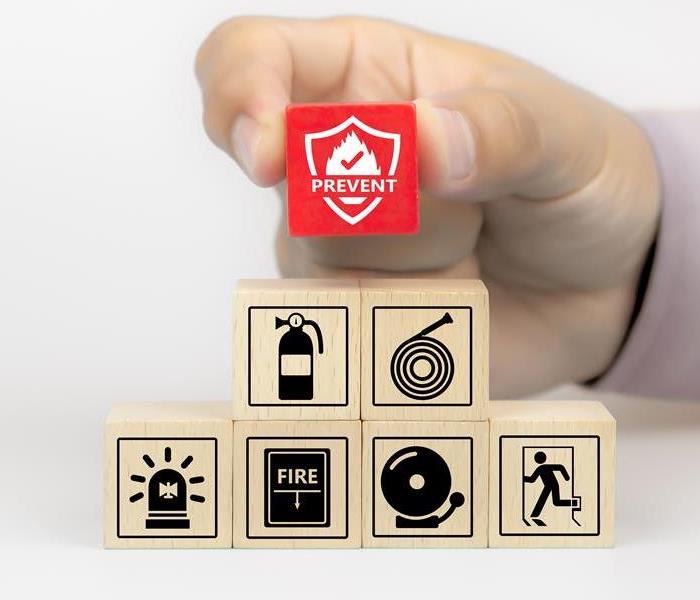 Know the basics of fire prevention.
Know the basics of fire prevention.
Pensacola, with its beautiful beaches and historic charm, is a wonderful place to call home. However, like any community, it's not immune to the threat of fires. Whether you're a long-time resident or new to the area, taking steps to protect your home from fire is essential. Here are some tips for fire prevention and preparedness in Pensacola.
Install Smoke Alarms: This is your first line of defense against fires. Make sure you have smoke alarms installed on every level of your home, including inside and outside of sleeping areas.
Test Smoke Alarms Regularly: Smoke alarms can only save lives if they're working properly. Test your smoke alarms at least once a month and replace batteries as needed.
Create a Fire Escape Plan: Sit down with your family and create a fire escape plan. Make sure everyone knows at least two ways to escape from every room in the house and establish a meeting place outside.
Practice Fire Drills: It's not enough to have a fire escape plan; you need to practice it regularly. Hold fire drills with your family at least twice a year to ensure everyone knows what to do in case of a fire.
Keep Fire Extinguishers Handy: Every home should have at least one fire extinguisher readily available. Make sure everyone in your household knows how to use it properly.
Clear Flammable Debris: Keep your yard and gutters clear of leaves, branches, and other flammable debris. These can easily ignite during a fire and spread flames to your home.
Maintain Your Electrical System: Faulty wiring is a common cause of house fires. Have a qualified electrician inspect your electrical system regularly and make any necessary repairs.
Be Careful with Space Heaters: If you use space heaters to supplement your home's heating system, make sure they're placed at least three feet away from anything that can catch fire, such as curtains or furniture.
Practice Safe Cooking Habits: Cooking fires are a leading cause of home fires. Never leave cooking food unattended, and keep flammable items away from the stove.
Keep Matches and Lighters Out of Reach: If you have young children, store matches and lighters out of their reach. Teach them that these items are not toys and should only be used by adults.
Be Mindful of Candles: Candles can add ambiance to your home, but they can also be dangerous if left unattended. Never leave candles burning in empty rooms, and make sure they're placed on stable surfaces away from flammable materials.
Stay Informed: Keep up-to-date on fire safety information and local fire regulations. Follow the guidelines set by the Pensacola Fire Department to ensure your home is as safe as possible.
By following these tips, you can help protect your home and family from the threat of fire in Pensacola. Remember, fire prevention and preparedness are ongoing efforts, so make them a priority in your household. Stay safe!
The Hidden Dangers: Understanding Mold and Its Impact on Your Pensacola Home
3/14/2024 (Permalink)
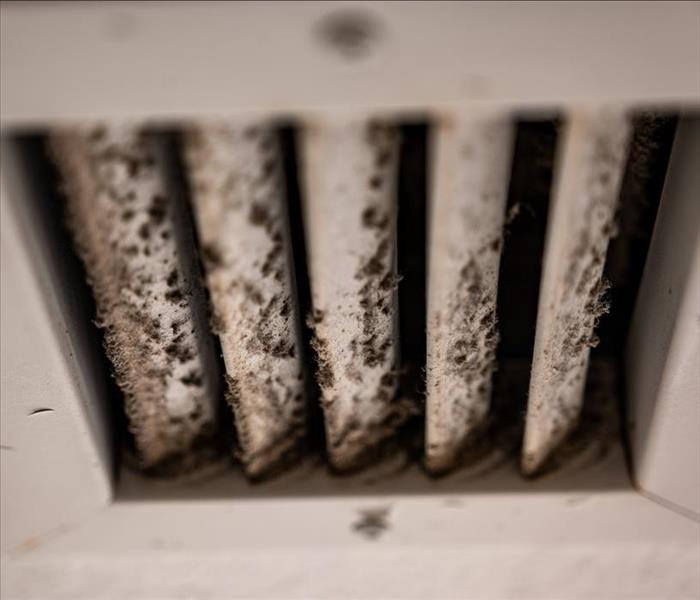 Mold growth on an air register.
Mold growth on an air register.
Living in Pensacola, Florida, has its perks: the beautiful beaches, vibrant culture, and warm climate. However, along with these benefits come certain challenges, one of which is dealing with mold in our homes. Mold might seem like a minor nuisance, but its impact can be far-reaching and potentially hazardous to your health and property. In this blog post, we'll delve into the hidden dangers of mold and how it can affect your Pensacola home.
What is Mold?
Mold is a type of fungus that thrives in moist environments. It can grow almost anywhere, including on walls, ceilings, floors, carpets, and even in your HVAC system. Mold reproduces by releasing spores into the air, which can then settle and grow in new locations.
The Hidden Dangers
Health Risks: Mold exposure can cause a variety of health issues.
Structural Damage: Mold can weaken the structure of your home over time. It feeds on organic materials such as wood, drywall, and insulation, causing them to deteriorate and eventually compromise the integrity of your property. This can lead to costly repairs and renovations.
Reduced Indoor Air Quality: Mold releases airborne spores that can contaminate the air you breathe indoors. Poor indoor air quality can exacerbate respiratory issues and allergies, leading to discomfort and health complications for you and your family.
Odor Problems: Mold growth often produces a musty odor that can permeate throughout your home. This unpleasant smell can be difficult to eliminate and may persist even after removing visible mold.
Prevention and Remediation
Fortunately, there are steps you can take to prevent mold growth and mitigate its impact on your Pensacola home:
Control Moisture: Keep humidity levels in check by using dehumidifiers and ensuring proper ventilation in bathrooms, kitchens, and other high-moisture areas.
Promptly Address Water Damage: Any leaks or water intrusion should be addressed immediately to prevent mold from taking hold. Thoroughly dry and clean affected areas as soon as possible.
Regular Maintenance: Inspect your home regularly for signs of mold growth, such as discoloration or musty odors. Address any issues promptly to prevent them from worsening.
Professional Remediation: If you discover mold in your home, it's essential to enlist the help of professionals for safe and effective removal. Attempting to remove mold yourself can disturb spores and exacerbate the problem.
Conclusion
Mold may be a hidden danger in your Pensacola home, but understanding its risks and taking proactive measures can help you protect your health and property. By controlling moisture, addressing water damage promptly, and seeking professional remediation when necessary, you can minimize the impact of mold and enjoy a healthier living environment in Pensacola.
Remember, when it comes to mold, prevention is key. Stay vigilant, and don't hesitate to seek assistance if you suspect mold growth in your home. Your health and well-being depend on it.
Water Woes: How to Handle Flood Damage in Pensacola Homes
3/14/2024 (Permalink)
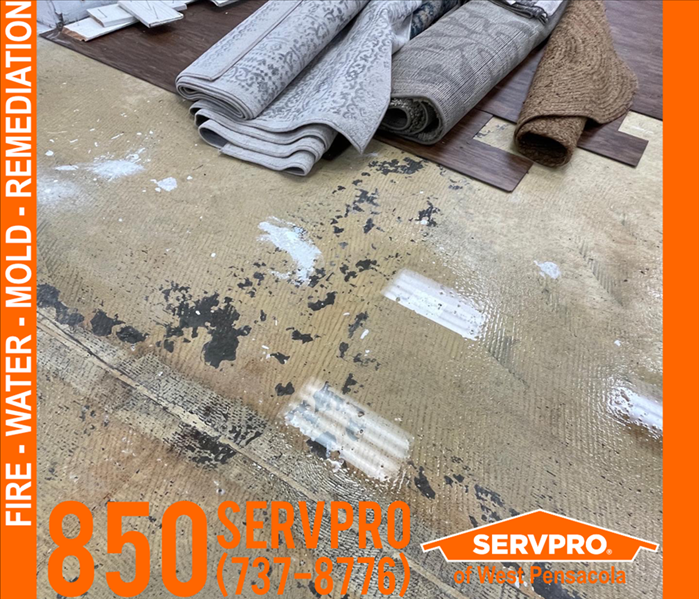 Water damage due to a flood.
Water damage due to a flood.
Living in Pensacola, Florida, brings many joys – the beautiful beaches, the vibrant culture, and the warm climate. However, it also comes with the risk of flooding due to its proximity to the Gulf of Mexico and its low-lying geography. Flood damage can wreak havoc on homes, causing immense stress and financial strain for homeowners. In this blog post, we'll explore the steps you can take to handle flood damage effectively and minimize its impact on your Pensacola home.
1. Safety First
Before you begin any cleanup or restoration efforts, ensure that you and your family are safe. If floodwaters are still present or if there is structural damage to your home, do not enter until it has been deemed safe to do so by authorities.
2. Document the Damage
Take photos and videos of the flood damage to your home for insurance purposes. Documenting the extent of the damage will help support your insurance claim and ensure that you receive the appropriate coverage for repairs and restoration.
3. Contact Your Insurance Provider
Notify your insurance provider as soon as possible to start the claims process. Be prepared to provide detailed information about the damage and any documentation you have gathered. Understanding your coverage and policy limits will help you navigate the claims process more effectively.
4. Mitigate Further Damage
If it is safe to do so, take steps to mitigate further damage to your home. This may include removing water, drying out affected areas, and boarding up windows or doors to prevent intruders or additional water from entering.
5. Hire professional flood damage restoration specialists
When you need flood damage restoration near you fast it can be a complex and challenging process that often requires specialized equipment and expertise. Consider hiring professionals who have experience in handling mold, water, and flood damage to ensure that your home is properly restored.
6. Remove Water and Debris
Pump out standing water from your home as soon as possible to prevent mold and mildew growth. Remove any debris or mud that may have accumulated inside or outside of your home to facilitate the drying process.
7. Dry Out Your Home
Use fans, dehumidifiers, and other drying equipment to dry out affected areas of your home thoroughly. This will help prevent mold growth and structural damage caused by excess moisture.
8. Clean and Disinfect
Thoroughly clean and disinfect all surfaces, furniture, and belongings that have come into contact with floodwaters. Use appropriate cleaning agents and follow recommended safety precautions to ensure that your home is safe and sanitary.
9. Dispose of Damaged Items
Dispose of any items that cannot be salvaged or safely cleaned, such as carpeting, insulation, and damaged furniture. Be sure to follow local regulations for disposal of flood-damaged materials.
10. Restore and Repair
Work with contractors and restoration professionals to restore your home to its pre-flood condition. This may involve repairing structural damage, replacing flooring and drywall, and repainting affected areas.
11. Take Preventative Measures
Once your home has been restored, take steps to prevent future flood damage. This may include installing flood barriers, elevating electrical systems and appliances, and landscaping to improve drainage around your home.
12. Stay Informed
Stay informed about flood risks in your area and take proactive measures to protect your home and family. Sign up for local alerts and monitor weather forecasts to stay prepared for potential flooding events.
Flood damage can be devastating, but with the right approach and resources, you can minimize its impact on your Pensacola home. By prioritizing safety, acting quickly, and seeking professional assistance, you can effectively handle flood damage and restore your home to its former glory.
Emergency Restoration: What to Do When Disaster Strikes in Pensacola
3/14/2024 (Permalink)
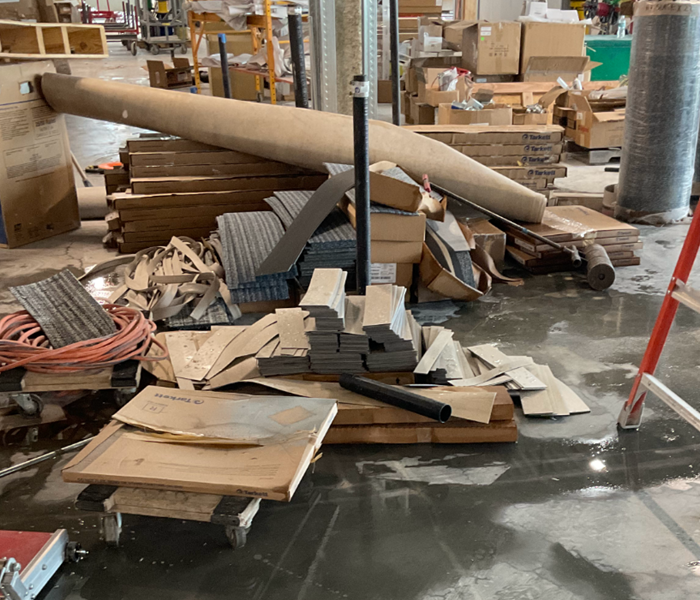 Commercial property with water damage.
Commercial property with water damage.
Disaster can strike at any moment, leaving devastation in its wake. In a place like Pensacola, with its susceptibility to hurricanes, floods, and other natural calamities, being prepared for emergencies is paramount. Knowing what steps to take in the immediate aftermath of a disaster can make all the difference in minimizing damage and ensuring the safety of yourself and your loved ones. In this guide, we'll explore what to do when disaster strikes in Pensacola, and how to initiate the restoration process to reclaim your home and your life.
Stay Safe, Stay Calm: The first and most crucial step is to ensure your safety and the safety of those around you. If the disaster involves immediate danger, such as flooding or structural damage, evacuate to a safe location as quickly as possible. Remain calm and focus on following emergency protocols.
Assess the Damage: Once it's safe to do so, assess the extent of the damage to your property. Take photographs or videos to document the destruction for insurance purposes. Be cautious of any hazards such as downed power lines or gas leaks.
Contact Emergency Services: If anyone is injured or trapped, or if there's a risk of further harm, dial emergency services immediately. This includes calling 911 for medical emergencies, fire, or police assistance.
Notify Your Insurance Company: Contact your insurance provider as soon as possible to report the damage. Provide them with all necessary information and documentation to expedite the claims process. Follow any instructions they give regarding mitigation measures and documentation.
Secure Your Property: Take steps to prevent further damage to your home and belongings. This may include boarding up windows, covering damaged areas with tarps, or shutting off utilities if necessary. However, only attempt these tasks if it's safe to do so.
Document Everything: Keep detailed records of all communication with insurance companies, contractors, and any other parties involved in the restoration process. Save receipts for expenses related to temporary repairs or accommodations.
Hire Professional Restoration Services: Seek out reputable restoration companies in Pensacola with experience in handling the type of damage you've incurred. Look for firms that are licensed, bonded, and insured, and that offer 24/7 emergency services.
Begin Cleanup and Mitigation: Once it's safe to enter your property, start the cleanup process to prevent further damage and mitigate risks such as mold growth. Wear appropriate protective gear and follow recommended safety procedures.
Work with Contractors: Coordinate with restoration contractors to assess the full extent of the damage and develop a comprehensive restoration plan. Be proactive in discussing timelines, costs, and expectations.
Stay Informed: Keep yourself informed about local developments, including weather forecasts and any updates regarding emergency services or disaster relief efforts in Pensacola. Follow official sources for accurate information.
Take Care of Yourself and Your Family: Coping with the aftermath of a disaster can be emotionally and physically draining. Make self-care a priority, and seek support from friends, family, or professional counselors if needed.
Plan for the Future: Once the immediate crisis has passed and the restoration process is underway, take steps to prepare for future emergencies. Review and update your emergency preparedness plan, including evacuation routes, emergency supplies, and communication strategies.
In conclusion, facing a disaster in Pensacola can be a daunting experience, but with the right preparation and response, you can navigate through the challenges and rebuild stronger than before. By following these steps and seeking assistance from professionals when needed, you can begin the journey toward restoring your home and your peace of mind.
Remember, in times of crisis, the Pensacola community stands together, offering support and solidarity to those in need. Together, we can overcome any challenge and emerge resilient in the face of adversity.
The Road to Recovery: Navigating Fire Damage Restoration in Pensacola
3/14/2024 (Permalink)
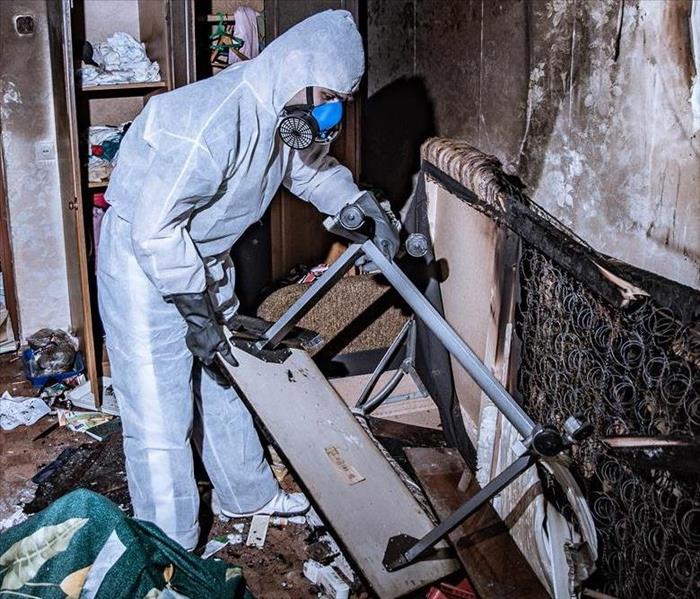 Fire Damage Cleaning and Restoration at a Residential Property
Fire Damage Cleaning and Restoration at a Residential Property
Fire can leave devastating effects on homes and businesses, leaving behind a trail of destruction that can seem insurmountable. For those in Pensacola, Florida, where the threat of wildfires is a reality, understanding the process of fire damage restoration is crucial. From the initial assessment to the final stages of rebuilding, navigating the road to recovery requires knowledge, patience, and the right support.
Assessment and Evaluation: The journey to recovery begins with a thorough assessment of the damage. Trained professionals will inspect the property to determine the extent of the fire damage, including structural issues, smoke damage, and water damage from firefighting efforts.
Safety First: Before any restoration work can begin, ensuring the safety of occupants and workers is paramount. This may involve securing the property, addressing electrical hazards, and implementing measures to prevent further damage or injury.
Cleaning and Restoration: Once the assessment is complete and safety measures are in place, the cleaning and restoration process can begin. This typically involves removing debris, cleaning soot and smoke residues, and salvaging as much of the property as possible.
Water Damage Mitigation: In many cases, firefighting efforts can result in water damage to the property. Water mitigation techniques, such as drying and dehumidification, are essential to prevent mold growth and further structural damage.
Odor Removal: Lingering smoke odors can persist long after the flames are extinguished. Professional odor removal techniques, such as ozone treatment and thermal fogging, are often necessary to eliminate unpleasant smells and restore indoor air quality.
Structural Repairs: Depending on the severity of the fire damage, structural repairs may be required to ensure the safety and stability of the building. This may include replacing damaged materials, reinforcing weakened structures, and repairing structural components such as walls, floors, and roofs.
Contents Restoration: In addition to restoring the structure itself, fire damage restoration often involves salvaging and restoring personal belongings and contents within the property. This may include furniture, electronics, clothing, and sentimental items.
Coordination with Insurance: Navigating the complexities of insurance claims can be overwhelming, especially in the aftermath of a fire. Working with experienced professionals who understand the insurance process can streamline the claims process and ensure fair compensation for the damages incurred.
Rebuilding and Reconstruction: Once the cleaning and restoration process is complete, the final step is rebuilding and reconstruction. This may involve rebuilding damaged structures, installing new flooring and finishes, and restoring the property to its pre-fire condition.
Emotional Support: Recovering from a fire can be emotionally draining for homeowners and business owners alike. Seeking support from friends, family, and professional counselors can help alleviate stress and anxiety during the recovery process.
Fire Prevention Measures: While recovering from fire damage is essential, taking steps to prevent future fires is equally important. Implementing fire prevention measures such as installing smoke detectors, maintaining fire extinguishers, and practicing fire safety protocols can help reduce the risk of future incidents.
Community Resources: In times of crisis, the Pensacola community often comes together to support those in need. Utilizing local resources, such as community organizations, disaster relief agencies, and volunteer groups, can provide additional assistance and support during the recovery process.
Navigating the road to recovery after fire damage can be challenging, but with the right knowledge, resources, and support, it is possible to rebuild and restore what was lost. By understanding the fire damage restoration process and taking proactive measures to prevent future incidents, residents and business owners in Pensacola can embark on the journey towards healing and recovery.
Mold Myths vs. Reality: Debunking Common Misconceptions for Pensacola Residents
3/14/2024 (Permalink)
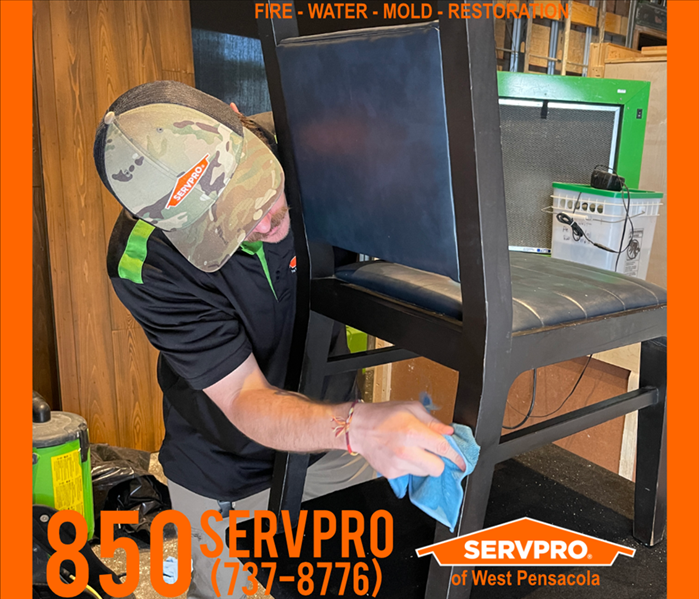 SERVPRO of West Pensacola Providing Mold Remediation
SERVPRO of West Pensacola Providing Mold Remediation
Living in Pensacola, Florida, you're no stranger to humidity. With the moist air comes the unfortunate risk of mold growth in homes. However, amidst concerns about mold, it's crucial to separate fact from fiction. Let's debunk some common misconceptions surrounding mold and arm Pensacola residents with accurate information.
Myth 1: Mold Only Grows in Dirty Homes
Reality: Mold spores are everywhere, and they thrive in moist environments. Even the cleanest homes can experience mold growth if there's excess moisture. Leaky pipes, high humidity, or water intrusion from storms can all create ideal conditions for mold, regardless of how immaculate your home may be.
Myth 2: Bleach Kills All Mold
Reality: While bleach can kill mold on non-porous surfaces, it's not effective on porous materials like wood or drywall. Moreover, bleach evaporates quickly, which means the mold roots may survive, leading to regrowth. Instead, opt for commercial mold cleaners or consult with professionals for safe and effective removal.
Myth 3: Mold is Harmless as Long as It's Hidden
Reality: Mold can cause health issues, even if it's hidden from view. Ignoring hidden mold can lead to worsening health conditions over time. It's essential to address mold promptly, regardless of its visibility.
Myth 4: You Can Remove Mold Yourself
Reality: While minor mold issues might seem manageable, DIY removal can be risky. Improper handling can spread mold spores and increase exposure. Additionally, without proper protective gear and techniques, DIY attempts may not fully eliminate the mold, leading to regrowth. Hiring certified professionals ensures safe and thorough mold remediation.
Myth 5: Mold Doesn't Affect Indoor Air Quality
Reality: Mold releases spores into the air, impacting indoor air quality. Regular inspection and maintenance to prevent mold growth are vital for preserving indoor air quality and overall health.
Myth 6: Mold Only Grows After Flooding
Reality: While flooding can certainly accelerate mold growth, it's not the only cause. Persistent high humidity, leaks, or inadequate ventilation can also foster mold development over time. Regularly inspecting vulnerable areas of your home, such as basements, attics, and bathrooms, can help identify and address mold issues early.
Myth 7: Mold Always Looks Black
Reality: While black mold (Stachybotrys chartarum) is infamous for its toxicity, mold comes in various colors, including green, white, and brown. Visual identification alone isn't sufficient to determine the type or severity of mold infestation. Consulting professionals for mold testing and inspection provides accurate assessment and appropriate remediation strategies.
Myth 8: Mold Remediation is Expensive
Reality: Ignoring mold problems can be far more costly in the long run. Mold growth can compromise structural integrity, damage belongings, and pose health risks. Timely remediation by qualified professionals can prevent extensive damage, potentially saving homeowners from more significant expenses down the line.
Myth 9: Mold Remediation Kills Mold Forever
Reality: Mold spores are pervasive, and complete eradication is impossible. However, effective remediation strategies can eliminate visible mold growth and create conditions inhospitable to its regrowth. Implementing preventive measures such as moisture control and proper ventilation is crucial for long-term mold management.
Myth 10: Moldy Smell is the Only Indication of Mold
Reality: While musty odors often accompany mold growth, they're not the sole indicator. Visible mold, water stains, peeling paint, and unexplained health issues can also signal mold presence. Proactive monitoring and addressing moisture issues promptly can help prevent mold infestations before they become noticeable.
Myth 11: Mold Doesn't Grow in Dry Climates
Reality: While mold thrives in humid environments, it can still develop in dry climates under specific conditions. Even arid regions like Pensacola can experience mold issues due to indoor humidity, water leaks, or inadequate ventilation. Proper moisture management remains critical in preventing mold growth regardless of climate.
Myth 12: Mold Will Go Away on Its Own
Reality: Mold won't disappear without intervention. Without addressing underlying moisture problems, mold will continue to spread and pose health risks. Ignoring mold growth can lead to more extensive damage and costly remediation efforts in the future. Prompt action is essential for mitigating mold-related issues effectively.
In conclusion, understanding the reality behind mold is crucial for Pensacola residents to protect their homes and health. By debunking common myths and embracing accurate information, homeowners can take proactive steps to prevent, detect, and remediate mold issues effectively. When in doubt, consulting certified professionals ensures safe and thorough mold management, preserving the well-being of both homes and occupants.
Remember, when it comes to mold, knowledge is power.
Safeguarding Your Space: Tips for Mold Prevention in Humid Pensacola Climates
3/14/2024 (Permalink)
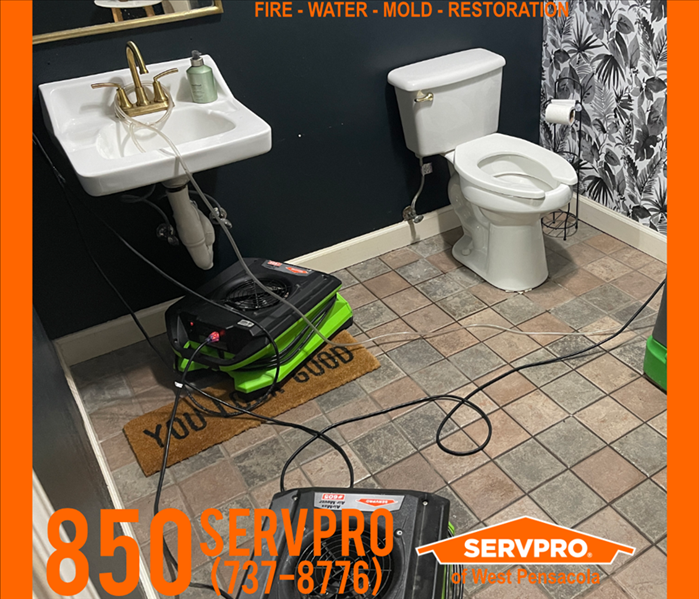 SERVPRO of West Pensacola providing a dry out with SERVPRO Air Movers
SERVPRO of West Pensacola providing a dry out with SERVPRO Air Movers
Living in Pensacola, Florida, offers its residents a unique blend of sunshine, beaches, and vibrant culture. However, with its coastal location comes high humidity levels, which can lead to mold growth in homes and businesses if not properly managed. Whether you're a long-time local or a newcomer to the area, safeguarding your space against mold is essential for maintaining a healthy environment. Here are some tips to help you prevent mold in the humid Pensacola climate:
Control Indoor Humidity: Invest in a good quality dehumidifier to regulate indoor humidity levels. Keeping the humidity between 30-50% greatly reduces the likelihood of mold growth.
Use Exhaust Fans: Proper ventilation is crucial, especially in areas prone to moisture buildup like bathrooms, kitchens, and laundry rooms. Install exhaust fans to remove excess humidity while cooking or showering.
Fix Leaks Promptly: Even minor leaks can lead to significant moisture accumulation, providing an ideal environment for mold. Regularly inspect and promptly repair any leaks in plumbing, roofs, or windows.
Improve Air Circulation: Ensure proper air circulation throughout your home by keeping furniture away from walls and allowing space for air to flow freely. Consider using fans to promote airflow in stagnant areas.
Clean and Dry Wet Areas: Be diligent in cleaning up spills and wet areas promptly. Use towels to dry wet surfaces and consider using a squeegee in shower areas to prevent water buildup.
Use Mold-Resistant Products: When renovating or building, opt for mold-resistant materials such as mold-resistant drywall and paint. These products are specifically designed to inhibit mold growth in high-moisture environments.
Inspect HVAC Systems: Regularly inspect and maintain your heating, ventilation, and air conditioning (HVAC) systems. Clean or replace filters as recommended and consider installing a UV light system to kill mold and bacteria in the air.
Keep Outdoor Debris Clear: Trim trees and bushes near your home to allow for proper airflow and sunlight exposure. Clear gutters and downspouts regularly to prevent water from pooling near the foundation.
Monitor Indoor Plants: Over-watering indoor plants can contribute to excess moisture in the air. Be mindful of watering habits and ensure proper drainage to prevent mold growth in plant pots.
Use Mold-Inhibiting Cleaners: Regularly clean surfaces prone to mold growth with mold-inhibiting cleaners. Pay particular attention to areas like shower curtains, tile grout, and basement walls.
Inspect Attics and Crawl Spaces: These areas are often overlooked but can be breeding grounds for mold if not properly ventilated. Inspect attics and crawl spaces regularly and ensure adequate ventilation to prevent moisture buildup.
Seek Professional Help: If you suspect mold growth beyond surface areas or if you're dealing with a persistent mold problem, don't hesitate to seek professional help. Certified mold remediation experts can assess the situation and provide effective solutions.
By implementing these tips, you can effectively safeguard your space against mold in the humid Pensacola climate. Remember that prevention is key, so stay vigilant and proactive in maintaining a healthy indoor environment for you and your loved ones.
Stay dry, stay mold-free, and enjoy all that Pensacola has to offer!

 24/7 Emergency Service
24/7 Emergency Service









